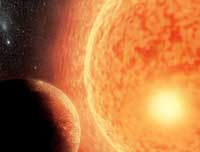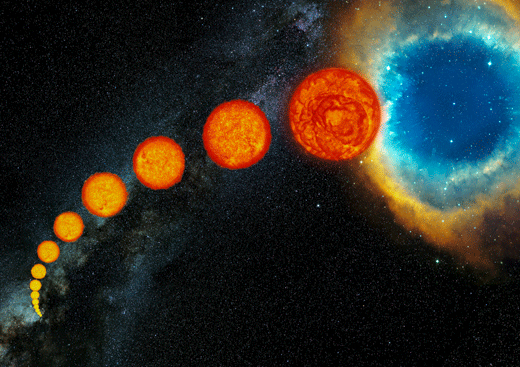A planet from another galaxy Understand article
As though planets from outside our Solar System were not exciting enough, astronomers have recently discovered a planet orbiting a star from outside our galaxy Johny Setiawan reports.

exoplanet around the star
HIP 13044
Image courtesy of Timotheos
Samartzidis
For two decades, astronomers have known that there are planets beyond our Solar System (Wolszczan & Frail, 1992). Orbiting other stars, they are known as extrasolar planets or exoplanets. So far, more than 500 exoplanets have been detected, the majority of which orbit stars with characteristics similar to those of the Sun (as described in Jørgensen, 2006). In particular, more than 90% of the stars hosting exoplanets are in the same evolutionary phase as the Sun – the main-sequence phase, during which stars burn hydrogen (see image below).

After several billion years, their fuel is almost exhausted and they start swelling, pushing the outer layers away from what has turned into a small and very hot core. These ‘middle-aged’ stars become enormous, and thus cool and red, and are known as red giants.
After the red giant phase, the star enters the horizontal-branch phase, during which the energy source is helium fusion in the core, and hydrogen fusion in the shell surrounding the core. This is the stage in which the star HIP 13044 is now.
Unlike much more massive stars, these Sun-like stars do not end their existence in dramatic explosions, but die peacefully as planetary nebulae, blowing out everything but a tiny remnant, known as a white dwarf.
To learn more about the evolution of stars, see Boffin & Pierce-Price, 2007 (small stars), Székely & Benedekfi, 2007 (massive stars) and the Langton Star Centre websitew1
Image courtesy of ESO / S Steinhöfel
Our research group at the Max Planck Institute for Astronomy in Heidelberg, Germany, however, concentrates on the search for planetary companions around stars that are not in the main-sequence phase, but in later evolutionary stages. These include what is known as the red giant phase, during which the star expands to hundreds of times its original diameter. The detection of planets around such giant stars is important for the study of the evolution of planetary systems. In particular, it allows us to predict the future of our own Solar System.
Recently, our team have successfully detected a planet around the star HIP 13044, which has left the red giant phase.
An extragalactic star
The star HIP 13044, which is about 2000 light years away from our Solar System in the southern constellation of Fornax (‘the furnace’), is significantly different from other known stars with planets. In particular, it has a very low abundance of the metal iron – less than 1% of what the Sun has. High metal abundance (stellar metallicity) is important in the core accretion model of planet formation: the more metal there is in the star system, the higher the probability of forming a planet. Given these low iron levels, we had not expected to find a planet around HIP 13044.
What makes this star particularly interesting, however, is the fact that HIP 13044 is one of a group of stars crossing our galaxy, the Milky Way, and orbiting the centre of the galaxy on similar orbits; such a group is known as a stellar stream. The Helmi stream, to which HIP 13044 belongs, is known to have its originoutside our galaxy (Helmi et al., 1999). It is assumed that the gravitational pull of the Milky Way drew these stars into our galaxy.
This is the first time that astronomers have detected a planetary system in a stellar stream of extragalactic origin. Because of the great distances involved, there are no confirmed detections of planets in other galaxies. But this cosmic merger has brought an extragalactic planet within our reach.
Detecting exoplanets
Although the star HIP 13044 and its attendant planet HIP 13044b are now within the Milky Way, they are still 2000 light years from Earth; whereas the star can be seen with a telescope, the planet itself is far too small to observe directly. How, then, did we detect it?
Using a technique known as radial velocity, we looked for tiny telltale wobbles of the star caused by the gravitational tug of its orbiting companion. By examining the stellar spectral lines at intervals, we detected changes to those lines (see diagram below). These indicate changes in the velocity of the star along the line of sight and can reveal the presence of an unseen low-mass companion, such as a planet. Although there are other techniques for detecting exoplanets (for example microlensing, as described in Jørgensen, 2006), the radial velocity method has proved the most successful. For these precise observations, we used the high-resolution spectrograph FEROS attached to the 2.2 m MPG / ESO telescope at the European Southern Observatory’s La Silla facility in Chilew2. This observatory is equipped with world-class instruments for detecting extrasolar planets.

In a star without a companion, the position of these lines in the spectrum shows no periodic change. However, the presence of an orbiting companion, such as a planet (blue ball) causes the star (orange ball) to wobble; the star’s movement is shown as a yellow line. As the star (not the planet!) moves towards us (towards the right of the diagram), the change in its radial velocity is negative (as shown in the graph, above); as it moves away from us (to the left), the change in its radial velocity is positive. This is reflected by a change in the position of the spectral lines: a positive change in radial velocity corresponds to a shift towards red wavelengths in the spectrum; a negative change corresponds to a shift towards the blue end. These changes are used to detect the presence of a companion orbiting the star. Click to enlarge image
Image courtesy of Johny Setiawan
Looking into our future?

HIP 13044 b is one of the few exoplanets known to have survived the red giant phase of its host star, during which the star expands massively after exhausting the hydrogen fuel supply in its core. The host star HIP 13044 has now contracted again and entered the horizontal branch, burning helium in its core. This is the first exoplanet detected around a horizontal-branch star. The discovery of HIP 13044 b, therefore, is particularly intriguing when we consider the distant future of our own planetary system; the Sun is already halfway through its life and is expected to become a red giant in about five billion years.
Not only the existence of the newly discovered planet is interesting; its characteristics are also unusual. HIP 13044 b has a mass at least 1.3 times that of Jupiter, the biggest planet in our Solar System, and orbits at a distance 0.12 that of the distance between the Sun and Earth (0.12 astronomical unit). Because it is so much closer to its host star than we are to the Sun, HIP 13044 b orbits its host star in only 16.2 days rather than the year it takes Earth. Such a small planetary orbit is common for stars in the main sequence, like the Sun, but is unusual for stars in late evolutionary phase like giant stars.
Our team hypothesises that the planet’s orbit might initially have been much larger, but that it moved inwards during the red giant phase. If the planet had been closer to the star, it may not have been so lucky: the star is rotating relatively quickly for a horizontal branch star, and one explanation is that HIP 13044 swallowed its inner planets during the red giant phase, which would make the star spin more quickly (for an explanation of why this is, see Carlberg et al., 2009)
Although HIP 13044 b has so far escaped the fate of these inner planets, the star will expand again in the next stage of its evolution. HIP 13044 b, having survived this long, may nonetheless be about to be engulfed by its star. This could also foretell the demise of even our outer planets – such as Jupiter – when the Sun approaches the end of its life.
References
- Boffin H, Pierce-Price D (2007) Fusion in the Universe: we are all stardust. Science in School 4: 61-63.
- Carlberg JK, Majewski SR, Arras P (2009) The role of planet accretion in creating the next generation of red giant rapid rotators.The Astrophysical Journal 700(1): 832-843. doi: 10.1088/0004-637X/700/1/832
- Helmi A (1999) Debris streams in the solar neighbourhood as relicts from the formation of the Milky Way. Nature 402: 53-55. doi: 10.1038/46980
- Download the article free of charge here, or subscribe to Nature today: www.nature.com/subscribe
- Jørgensen UG (2006) Are there Earth-like planets around other stars? Science in School 2: 11-16.
- Székely P, Benedekfi Ö (2007) Fusion in the Universe: when a giant star dies… Science in School 6: 64-68.
- Wolszczan A, Frail DA (1992) A planetary system around the millisecond pulsar PSR1257 + 12. Nature 355: 145-147. doi: 10.1038/355145a0
- Download the article free of charge here, or subscribe to Nature today: www.nature.com/subscribe
Web References
- w1 – The Langton Star Centre supports research groups of school students who are involved in cutting-edge scientific research. To learn more about the life cycle of a star, see the resources on the website: www.thelangtonstarcentre.org
- To find out how physics teacher Becky Parker established The Langton Star Centre, see:
- Stanley S (2011) Schoolhouse scientists. Science in School 19: 69-72.
- w2 – The European Southern Observatory (ESO) builds and operates a suite of the world’s most advanced ground-based astronomical telescopes. ESO is a member of EIROforum, the publisher of Science in School. To learn more about ESO, see: www.eso.org
Resources
- To find out more about the research described in this article, see:
- Setiawan J et al. (2010) A giant planet around a metal-poor star of extragalactic origin. Science 330(6011): 1642-1644. doi: 10.1126/science.1193342
- To learn about the European Space Agency’s search for exoplanets, see:
- Fridlund M (2009) The CoRoT satellite: the search for Earth-like planets. Science in School 13: 15-18.
- To learn more about exoplanets, see the press kits (in English and Spanish) on the ESO website: www.eso.org/public/products/presskits
- To find out how to build your own spectrometer and examine the spectral lines of the Sun, see:
- Westra MT (2007) A fresh look at light: build your own spectrometer. Science in School 4: 30-34.
Institutions
Review
Before reading this article, I had not known that our galaxy, the Milky Way, hosts streams of stars from other galaxies. I was fascinated by the story of these alien visitors and an exoplanet on a galactic trip.
For teaching purposes, I thought first of gravity – how powerful it can be, how universal and over what long distances it works. The article could also be easily applied to other topics in physics, chemistry, astronomy and earth science: mass, the Doppler effect, spectroscopy (absorption and emission lines), metal abundance in the Universe, the mutual attraction of celestial bodies and planetary accretion. It could be used as the basis of a discussion on cosmology, the history of the Solar System and the search for Earth-like planets and extraterrestrial life.
It could also be used for a discussion of how science works: how hypotheses and theories begin with new observations and discoveries, and are based on previous scientific achievements and established techniques, by scientists who are open to possibilities that had never before been considered.
Marco Nicolini, Italy





